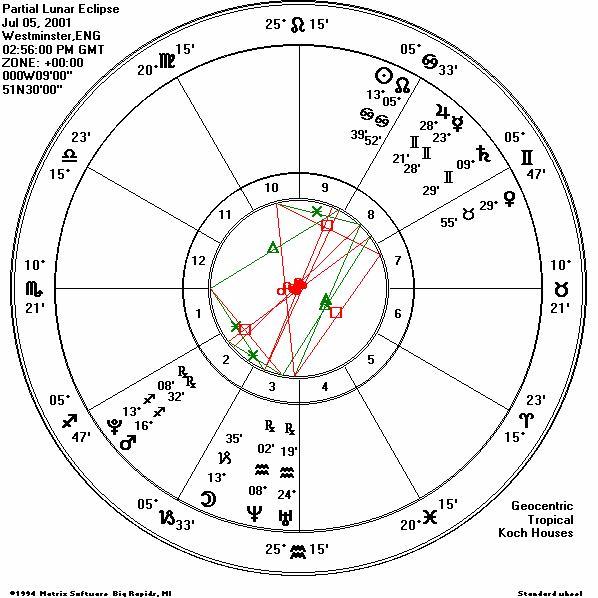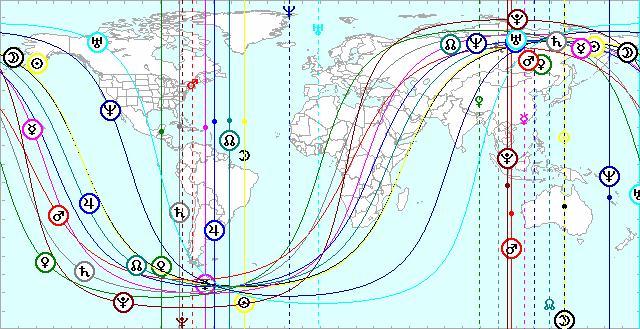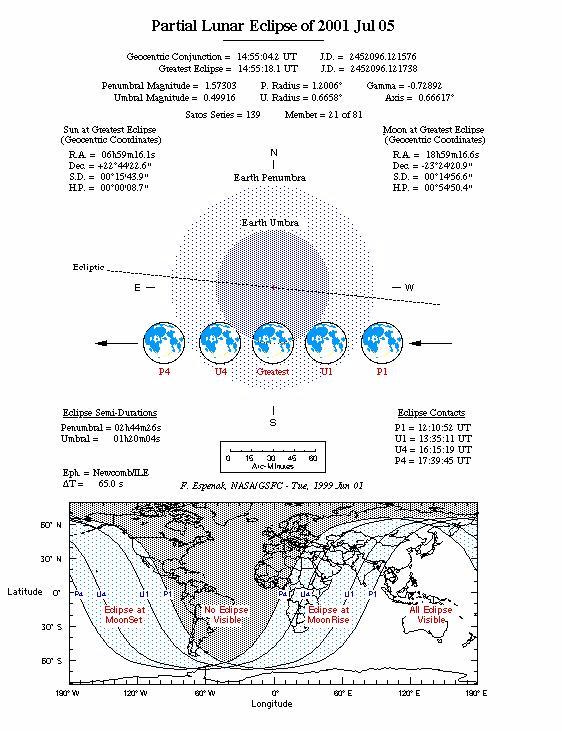
PARTIAL LUNAR ECLIPSE
JULY 5th 2001.
The Partial Lunar Eclipse on July 5th 2001 occurs at 14 degrees Capricorn. The 'goaty' Moon at that time makes no planetary aspect but begins a long build up to an earthy waning trine to Venus. The fundamental tone of this eclipse is one of 'the knowledge of value and quality'. It is essentially a benevolent eclipse. Uranus is in airy trine to Jupiter, high tech advances are taking place, Saturn is similarly trined to Neptune, a fertile period for the arts. Saturn is applying to an opposition to Pluto. This is an accompanying note of mass compulsion to proceedings (see below) . The astrological chart for the eclipse demonstrates a classic 'seesaw' planetary picture which has been building up in the skies for a number of weeks, corresponding to a similar polarisation underway at this present time in society.
The parent 'Saros Cycle' to which this eclipse belongs began in 1623. The cycle is well established (at its first quarter point) and waxing in intensity. This eclipse is number 21 of 81. The last eclipse in this Saros series was in 1983, and before that in 1965, and 1947.
The timings of the eclipse ( in GMT ) are as follows:-
Penumbral Eclipse starts 12.11
Umbral eclipse starts 13.35
Maximum Eclipse occurs 14.55
Umbral Eclipse finishes 16.15
Penumbral Eclipse finishes 17.40
This eclipses centres on Australia an the far East. What follows is an analysis of the astrological perspective from major cities in the world at the exact moment of greatest eclipse.
It is Moonrise and Sunset at Durban and Leningrad The Moon is exactly conjunct the MC of Adelaide. The Moon is due west and the Sun due east at Calgary and Oklahoma City. Saturn sets and Pluto rises over Crete. Saturn conjuncts the MC of Toronto as Pluto conjuncts the IC. On the other side of the world Pluto and Saturn straddle the MC/IC axis of Bangkok. At London, where Scorpio rises, Uranus conjuncts the IC. Mars and Saturn are aligned East/West at Edinburgh. At New York Pluto conjuncts the IC. and Uranus is due west.
The next eclipse after this 'minor but significant' partial lunar is an annular solar eclipse on Dec. 14th 2001, followed by a penumbral lunar eclipse on December 30th 2001. The next total lunar eclipse is on Friday May 16th 2003 at 03-40.
The next Total Solar Eclipse is Dec. 4th 2002.



(All following taken from:- http://sunearth.gsfc.nasa.gov/eclipse/eclipse.html)
The second lunar eclipse of the year is partial and occurs in eastern constellation not sign (daze italics) of Sagittarius three degrees north of Nunki (Sigma Sag). The event is a moderate partial eclipse with the Moon's northern limb dipping 15 arc-minutes into Earth's umbral shadow. The penumbral phase begins at 12:10.9 UT, but most observers will be unable to detect any shading during the first half hour or so. The partial eclipse commences with first umbral contact at 13:35.2 UT. Two hours and forty minutes later, the partial eclipse ends at 16:15.3 UT. Although it can not actually be observed, the eclipse technically ends when the Moon leaves the penumbral shadow at 17:39.8 UT.
At the instant of mid-eclipse (14:55.3 UT), the Moon will stand at the zenith for observers in central Australia. At that time, the umbral eclipse magnitude peaks at 0.4992 as the centre of the Moon passes along the southern edge of the umbra. Unfortunately, none of the partial phases will be visible from North America except from the Aleutian Islands. The eclipse is best seen from the western Pacific, Asia and Australia. The Moon's path through Earth's shadow(s) as well as a map showing worldwide visibility of the event is shown in .